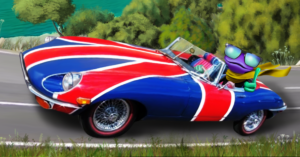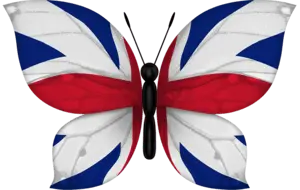The Green Sea Turtle – Taurus

General facts About Sea Turtles:
With seven different species, the gentle Sea Turtle is one of the crowning jewels of the ocean. Casually gliding long distances, these reptiles cover a lot of ground! These amazing turtles can be found basking in shallow beds of seagrass. Dwelling around tropical and sub-tropical coastlines. But they are also happy traversing the depths of the Pacific Ocean.
The Ocean is their primary Habitat, with most of their lives enjoyed at sea. Occasionally, they will swim ashore to sunbathe or nest, but they never stay for long. The Sea Turtle dates back 110 million years to the Jurassic Period. The Archelon is long extinct but this dinosaur passed down its strongest attributes to its smaller modern-day relatives. The 7 known species of Sea Turtle today are: The Green Sea Turtle. The Loggerhead. The Flatback. The Hawksbill. The Olive Ridley. The Kemp’s Ridley.

Introduction:
The Green Sea Turtle, or Chelonia mydas is the largest species of hard-shelled turtle. There are two subspecies of this turtle: The Atlantic and the Eastern Pacific. There are many debates on whether there should be 2 species of Green Sea Turtle or if they should be classified as one. This is because their plastron (shell) varies in shape and colour depending on location. The Atlantic turtles have yellowish plastrons, while the Pacific has a dark greyish-blue colour. The consistency held between both species is the defining green colour of their skin, giving these turtles their name.
Green Sea Turtles are solitary travellers. They only gather to mate and share feeding grounds once every 2-4 years. Otherwise, these reptiles can be observed gliding through ocean currents in solitude.
The Green Sea Turtle: Out of the Blue!
What is the size, weight & colour of the Green Sea Turtle?
The Green Sea Turtle is the largest hard-shell turtle in the world. They are the second-largest sea turtle next to the Leatherback. These reptiles weigh up to 318kgs and can grow up to 1.5m long. Their heads are proportionately small, compared to the rest of their body, and cannot be retracted like other turtles. Male Green Sea Turtles are only slightly larger than females, with many being the same size.
Our friend has many textures and patterns! This blend of shades includes brown, grey, black, yellow, and green on the shell, with a yellow underbelly. Their skin on the fins and head is green with brown and yellow markings.
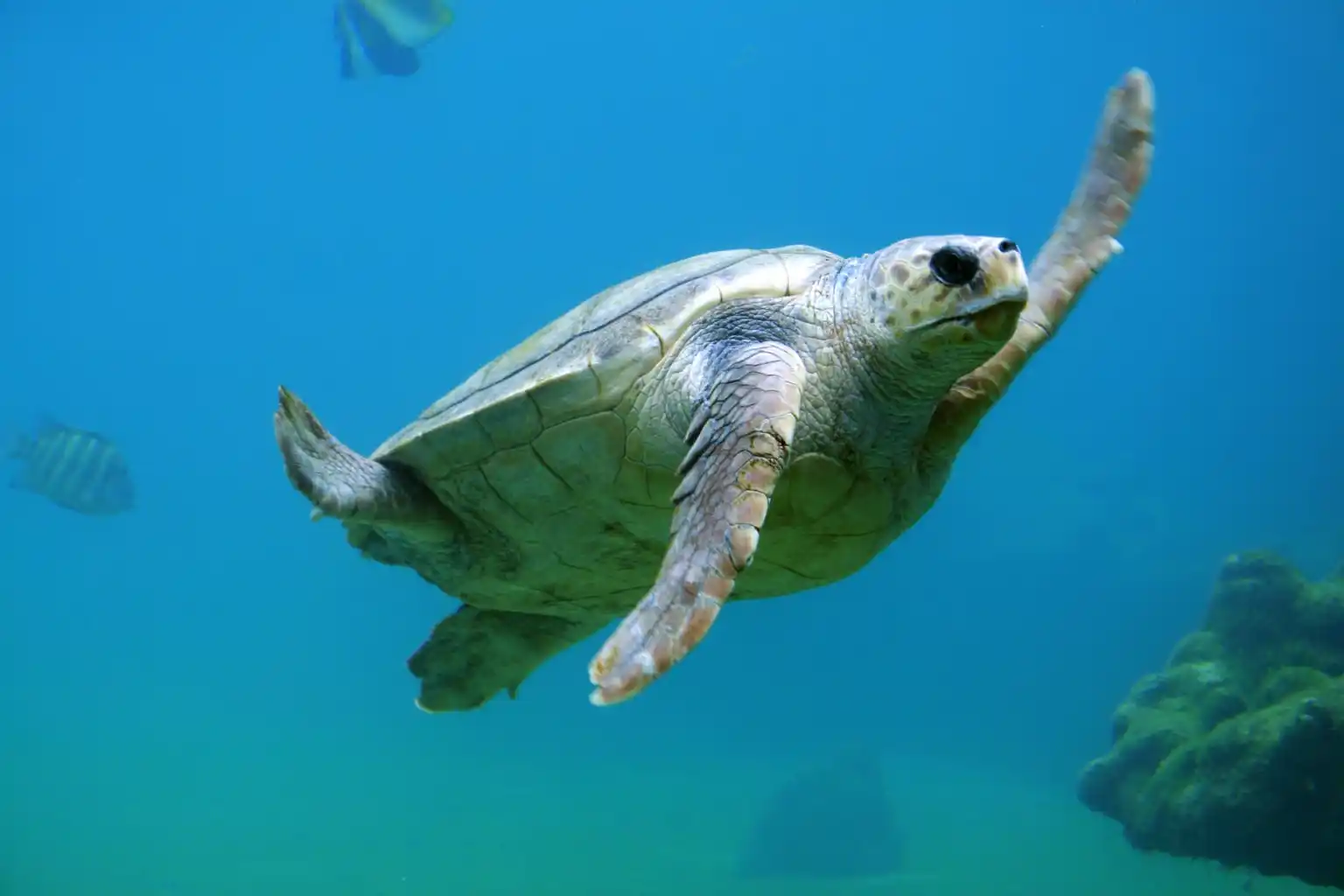
What type of vision does the Green Sea Turtle have, and what sounds do they make?
The Green Sea Turtle has vision that’s adapted for the open ocean. They’re short-sighted on land, but thankfully this is not where they spend the majority of their time. This strong eyesight in water is due to their colour spectrum – with oceanic tones such as blue, green, violet, and yellow being the most vivid.
Sea turtles do not have vocal cords and their ears are internal. Yet, there is evidence that baby sea turtles communicate with each other to synchronize hatching time! Scholars are still undecided on how Green Sea Turtles communicate.
Are there any special or unique physical attributes?
For reptile enthusiasts, Green Sea Turtles can be identified by their intricate carapace (shell). On this shell, you will find scutes, which are the grid-like markings. Our friend has 5 central scutes, and 4 on either side. Our friends can also easily be identified through their long hydrodynamic tails. These tails can extend beyond their hind flippers and act as an excellent stabilizer.
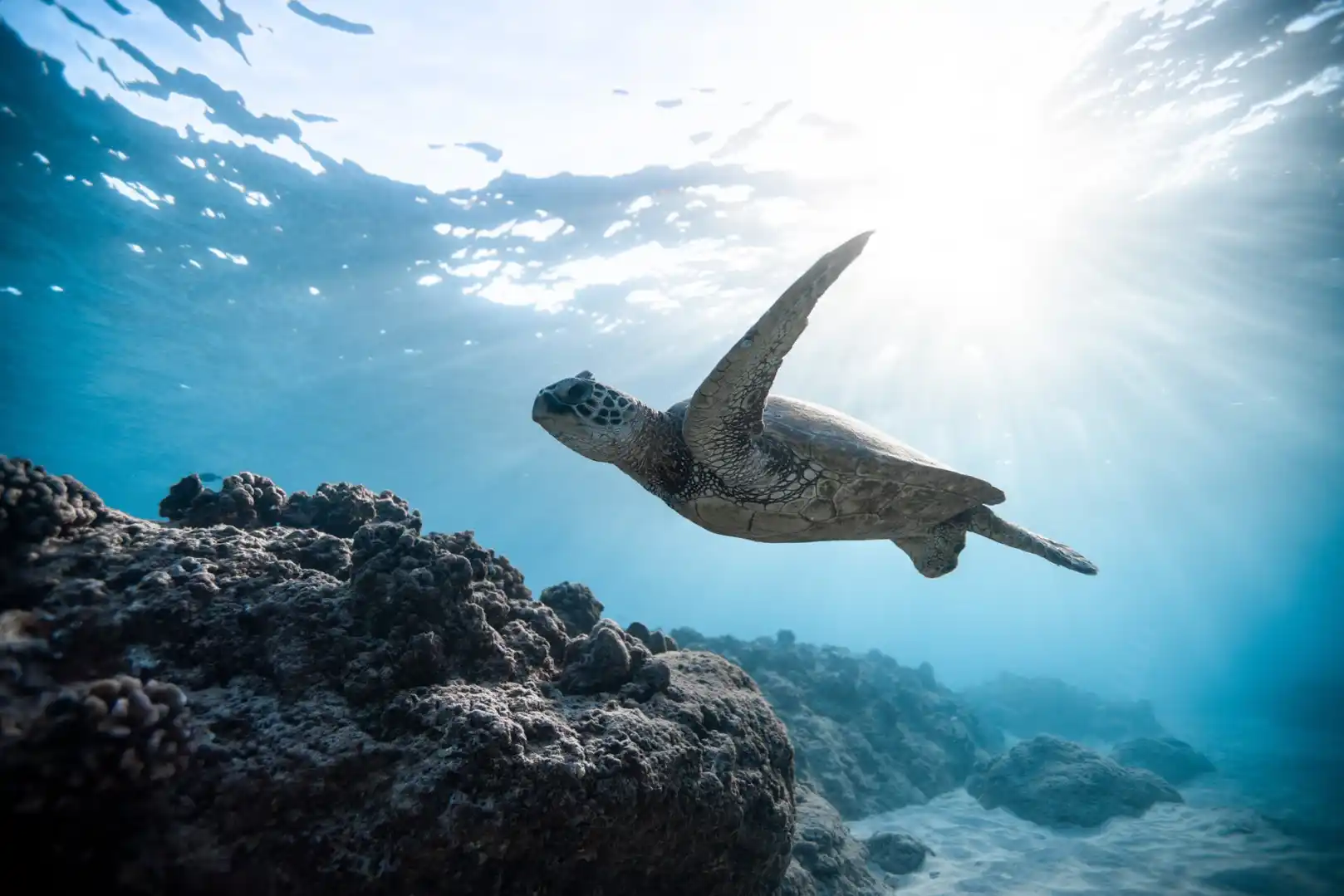
How fast is the Green Sea Turtle?
Our friend has a teardrop-shaped, streamlined body that aids in hydrodynamics. They can reach speeds of 56 km/h with great ease. With their paddle-shaped fins, they can drift through ocean currents gracefully and quickly.
What do they eat?
The Green Sea Turtle has a varied diet. At the age of 15, (when it is fully grown) they develop a herbivore diet and feed on seagrass. This diet is important for the environment because it prevents overgrowth in coastal areas. With help from their fully developed serrated jaw, they break down food by tearing and chewing. Juvenile Green Sea Turtles are omnivorous, as they feed on insects, crustaceans, and worms.

Who are their natural enemies?
These turtles may be our friends, but they are not friends to all. The Green Sea Turtle has multiple predators such as Sharks and Killer Whales. They are more vulnerable as hatchlings, as they often fall prey to dogs, seabirds, raccoons, crabs, and fish.
Where do they live?
Our friends can be found cruising off the coast of 140 countries in the Atlantic and Pacific Ocean. Nesting can be found in 80 of these countries with warm climates. Their ability to live in tropical and subtropical waters makes for vast differences in their markings and colour. Younger turtles will stay close to shore for protection among the long seagrasses and gradually move to deeper waters as they age.
What are their migration habits and routes?
Green Sea Turtles will travel long distances to graze upon seagrasses, and they will make the long journey back to breed in their natal beach. They stay near the shorelines for food, but also spend a lot of their life in the open ocean. For example: The Green Sea Turtle will travel from Ascension Island in the middle of the south Atlantic to Northern Brazil for feeding grounds.

Do they travel long distances?
Green Sea Turtles can travel up to 2,600km between nesting and feeding grounds. This is accomplished with their strong, paddle-like flippers propelling them effortlessly through the water.
All about Reproduction:
It takes 20-50 years for the Green Sea Turtle to reach sexual maturity, with most developing at 25-35 years. Females have been known to nest for 38 years during their life span. This nesting period occurs on sandy beaches once every 2-4 years. The mother will return to the same beach they hatched on and lay a clutch of 100-200 eggs. She digs a pit in the sand and leaves her eggs to incubate for 2 months. The hatchlings must make the trip from land to sea by themselves, and it will be the most dangerous moment of their lives. More than 90% of hatchlings never make it to the sea.
Life Span:
Luckily, their life expectancy is 80-100 years! However, environmental factors can easily cut this lifespan short. All it takes is a case of Fibro-papillomatosis and it can infect 50-70% of a sea turtles’ population. This collection of benign tumors can affect the turtle’s eyesight and hearing until they can no longer defend themselves.
Myths:
This long-life span has inspired a lot of mythology dedicated to wisdom, patience, strength, and luck. In Hinduism, Akapura is a turtle who carries the entire world on his back, also known as “The World Turtle”. In many religions, the Sea Turtle is an icon of the sea, and seen as a signifier of wellbeing.
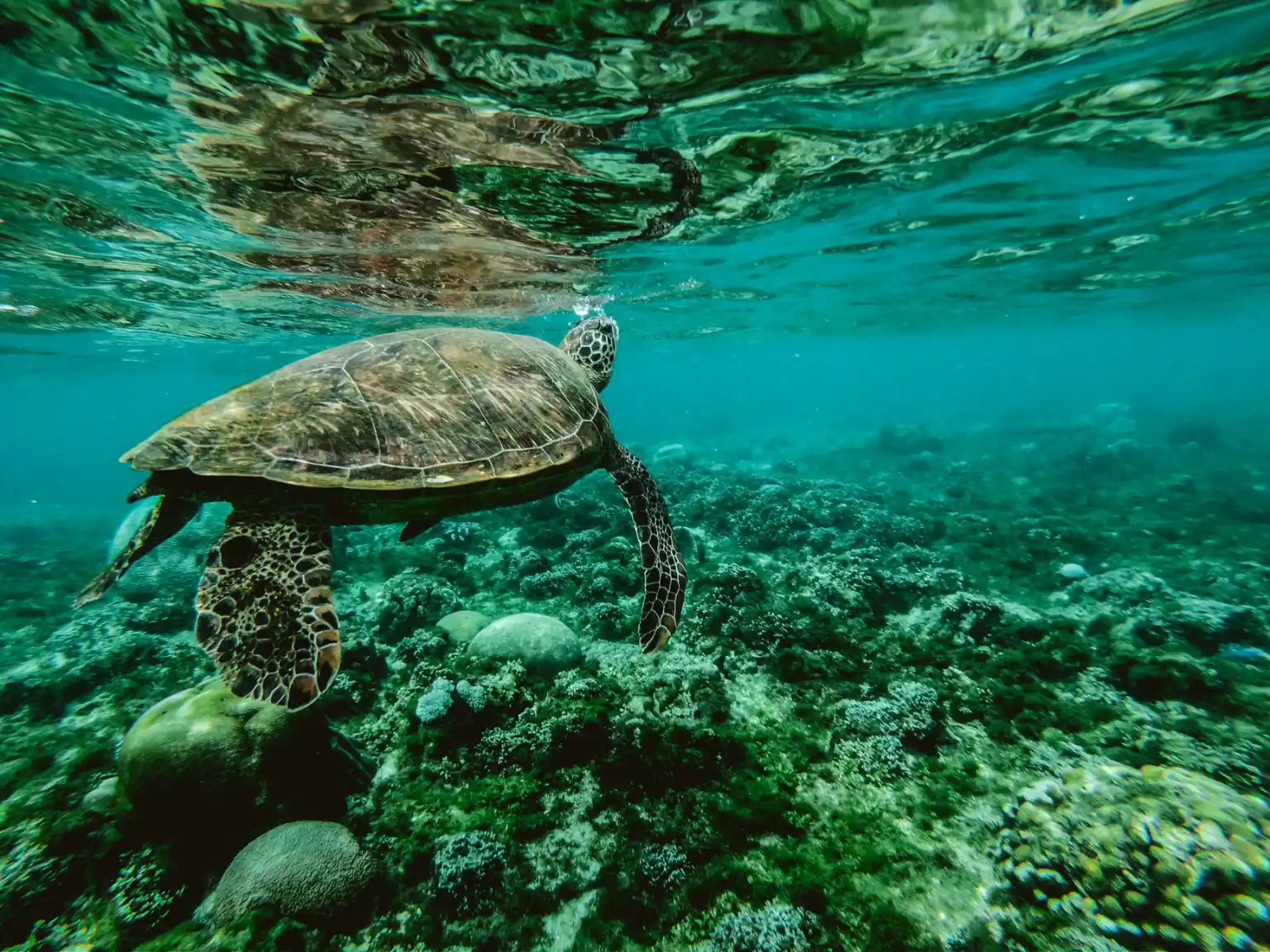
What threats do Green Sea Turtles face?
In the last 50 years, the population of Green Sea Turtles has decreased by 90%. This is due to many factors such as habitat loss, climate change, and overhunting. The fins and flesh of Sea Turtles are often hunted for a variant of fin soup, which is widely consumed. These are all threats for adult turtles; however, young turtles face more challenges than predators. Light pollution from human activity confuses hatchlings to move towards roads and pathways instead of the ocean. This results in many being run over by cars and other human activities.
Endangered Ranking:
The Green Sea Turtle in all of it’s geographical locations is listed as endangered or threatened by the Endangered Species Act, the IUCN, and CITES. It is illegal to harm or hunt Green Sea Turtles in most countries, with their nesting sites also being protected. With about 90,000 nesting females left, and a 20-50-year sexual maturation period, it will be very difficult to maintain this population. This is due to bycatch fishing, habitat loss, and light pollution.
Why should you care?
Our friends are like a naturally occurring lawnmower. They have an important role in maintaining Coral Reefs and Seagrass beds. Without the Green Sea Turtle, invasive seagrasses would swallow up Coral Reefs and deplete their access to sunlight. Humans rely on Coral Reefs for half of the world’s oxygen and to consume carbon dioxide. They also help cycle nutrients in the water around them which aids smaller microorganisms. The Green Sea Turtle has an important place in the food chain, and without them, the oceans would suffer.
What can you do to help?
Ethical Consumption: While the consumption of Green Sea Turtles is illegal, many are still caught and sold as bycatch. Turtle soup is still a delicacy in China and the USA. If you want to help the Green Sea Turtle, eliminate it from your diet!
Spread the word! Talk to family members and friends about what they’re doing to help the cause. Inform people on ways they can help protect the Green Sea Turtle and its habitat. There are many charities that aim to protect Sea Turtle mating grounds.
Get Involved: Lastly, spend time signing petitions and getting involved in online spaces. If you can, take part in coastal clean-ups to keep Sea Turtle habitats litter-free.
If there is a public demand for change, then change will come. With everyone’s help, we can create new standards for the ocean and all of its inhabitants! With safer oceans, we will continue to see the Green Sea Turtle’s populations stabilize.
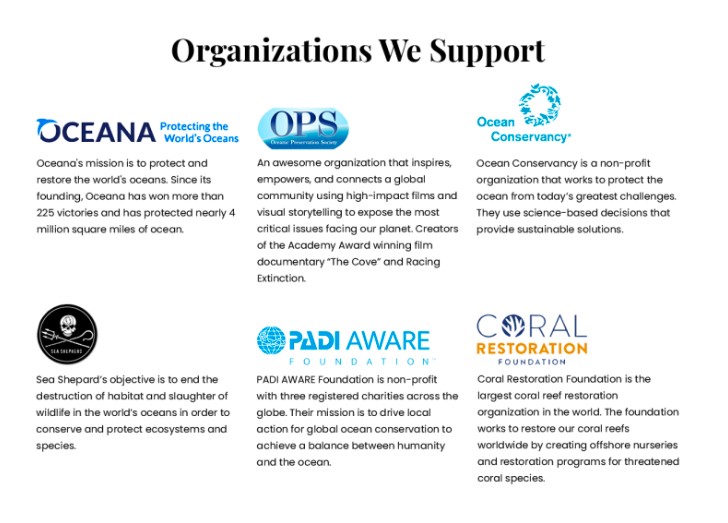

Bethany MacDonald
Bethany MacDonald has contributed articles LillyPad.ai since 2020. As their Blog Lead, she specialises in informative pieces on culture, education, and language learning
